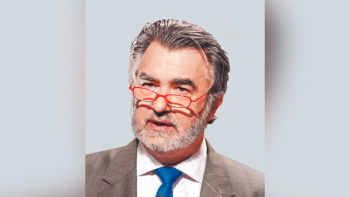
New Opportunities for DCT Efficiency
Tom Brazier, director decentralized clinical solutions at mdgroup, explains how to improve the availability and accessibility of decentralized solutions.
The number of clinical trials being conducted via the decentralized and hybrid model has increased significantly in recent years, thanks to its ability to make research more efficient and participation more accessible. This new dawn brings with it new considerations, not least best how to align the needs and priorities of the multiple vendors and stakeholders in a way that unlocks the approach’s full potential. A lack of communication between labs and mobile health providers, for example, can hamper proceedings, leading to delayed visits, missed datapoints and increased costs, but is easily fixed.
Tom Brazier, director decentralized clinical solutions at mdgroup, explains how to improve the availability and accessibility of decentralized solutions and boost awareness of how and when they should be used to get the biggest benefit.
Applied Clinical Trials: Can you outline the practicalities of decentralized clinical trials (DCT) conduct and what is involved?
Tom Brazier: In the wake of the COVID-19 pandemic, decentralized clinical solutions have emerged as an important tool to improve clinical trial accessibility. They allow many trial procedures to be conducted remotely, using a combination of services and technology including telemedicine appointments and mobile apps for remote data collection.
The number of clinical trials being conducted via the DCT, and hybrid model continues to grow: the market was worth around $8.8 billion in 2021 and it’s expected to increase by 10% year on year.1
But DCTs are a new tool so embedding them into routine workflows relies on having the right processes in place. We know there are challenges when trials include visits outside a traditional research site, but sponsors and CROs have to think about how to set in stone the right procedures for these studies, including establishing a clear and direct line of contact between central laboratories and mobile health providers from the outset.
ACT: Where do issues occur–and what can be done?
TB: It all boils down to communication and getting all the stakeholders involved early on, whether that is the central lab being involved when the protocol is developed or sponsors working closely with the mobile health provider to make sure the right staff, processes and equipment are in place. Once sponsors and CROs understand the interaction points between their various service providers, they can mitigate a host of potential delays.
One area where issues can arise between central labs and mobile health providers is sample queries. Most labs will send their queries to sites, who then forward them to mobile health vendors who contact their field workers to resolve the request. If site staff could contact home care workers directly, that would save a step. The process would be further streamlined if labs could create home visit kits and separate visits in their system in order to direct queries to home care workers.
ACT: Are sites nervous about remote visits?
TB: Sites can be apprehensive about remote visits because of the requirement for them to have oversight of someone they have possibly not met before. This can be resolved by building the relationship between us and the site, and our healthcare professionals (HCPs) and the site, whether that's via face-to face meetings or, in an ideal world, sending HCPs to site initiation visits for in-person training from the start of the study instead of training them virtually. Often if a site can meet the HCPs in person, it can allay any misgivings.
There is more we can do on the tech side too, for example bringing site staff virtually to remote visits through telehealth platforms, perhaps to oversee the first few visits on a trial to ensure the patient is happy with the process and the site is happy with the quality of the HCP's work. That also allows transparency between our HCPs and the site team.
We work on strategies to ensure site staff don’t feel marginalized and take advantage of video when appropriate, so everyone feels engaged and able to fulfil their responsibilities in terms of oversight.
ACT: So direct communication is always preferable?
TB: Poor communication between laboratories and mobile health providers can result in a lack of alignment on sample collection kit contents which in turn can delay scheduled visits and lead to avoidable repeat visits, meaning shifting timelines and increased costs. In addition to communicating clearly about equipment, mobile health providers and labs need to work together to make sure the instructions they give the nurses are clear, easy to replicate in a patient’s home and preserve sample viability.
This is essential for preventing delays in sample testing and data release: we also want to see sample stability, courier capabilities and lab opening times all discussed in an open manner. This is the sort of information that needs to be talked about from the outset to ensure suitable logistics solutions are implemented. There are so many benefits to a decentralized model in reducing patient burden, but it really depends on sponsors/CROs, mobile health providers and central labs all being aligned.
ACT: What would you like to see more of going forwards?
TB: Early, clear, and transparent communication between all stakeholders: that is the goal. Making sure the lab is aware that there is a mobile health component to the study is essential. This allows seamless integration of remote sample collection processes from the outset, reducing re-work. The lab manuals may need to be modified and that all takes time, which is often of the essence. We want to be in touch with the central lab to know about standard processes that have been validated, for example, which will mean a smoother process and a better return on investment.
There is also a big opportunity for improvement with training HCPs for remote visits. There is limited to no collaboration between companies like mdgroup, who are sourcing the HCPs and training them on the lab requirements, and companies who are creating the lab requirements. Improved collaboration has huge scope to improve the quality of training materials. It could also enable sponsors to review the professional records of HCPs before site visits, providing additional transparency and reassurance.
It is crucial to have a close relationship between HCPs and site staff; as soon as the specimen is shipped, the site can be made aware so it can be tracked. Our aim is to make the framework for remote visits as standard and as seamless as possible, regardless of where the sample comes from.
Reference
1. https://www.globenewswire.com/en/news-release/2022/05/26/2451326/0/en/Global-Decentralized-Clinical-Trials-DCTs-Market-valued-at-US-8-8-billion-2021-is-set-to-witness-a-healthy-growth-rate-of-10-to-reach-US-14-2-billion-by-2026.html
Newsletter
Stay current in clinical research with Applied Clinical Trials, providing expert insights, regulatory updates, and practical strategies for successful clinical trial design and execution.






.png)



.png)



.png)
.png)
